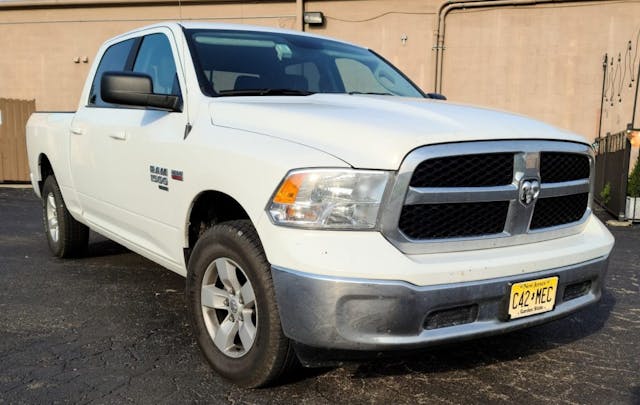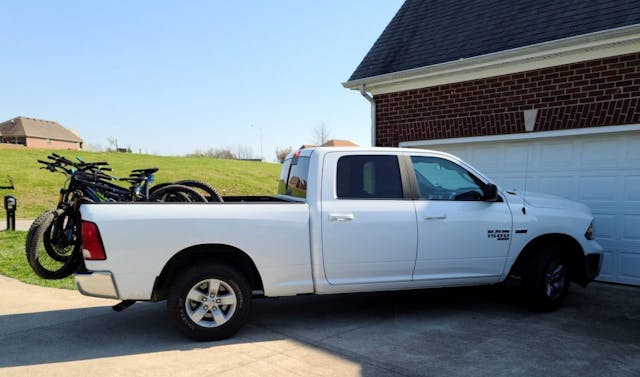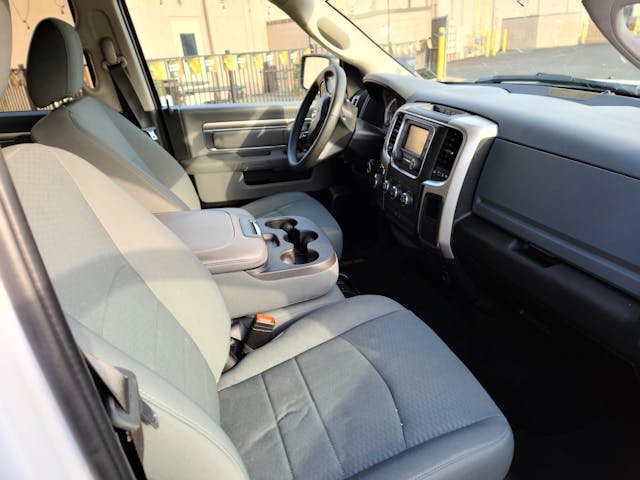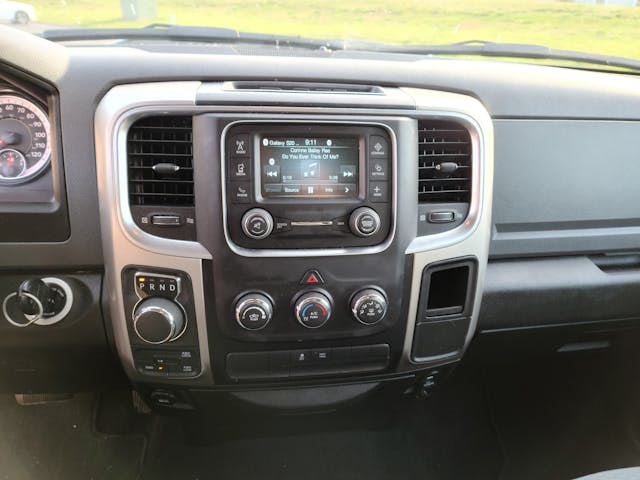Review: 2020 Ram 1500 Classic 4×4 Tradesman SLT

Last August, my son and I took a new Ram Limited on a 6124-mile cross-country cycling trip. It would be an understatement to say that the Ram performed with distinction; in fact, I walked away from the two-week test prepared to recommend a high-dollar Chrysler (er, FCA, er, Stellantis) truck not just to would-be pickup buyers but also to anyone who was interested in a Lexus LS or 7 Series BMW.
Not that they’d save a lot of money in doing so; the high-end half-ton Rams are north of seventy grand. Ah, but there’s an alternative. In yet another example of a strategy pioneered by Ford in 1997 but also currently employed by Chevrolet (with the “LD” half-ton), Ram will sell you the previous-generation truck as the “Classic.” If you spec it right, it’s quite a bit cheaper than the current Ram, and it’s made in America.
To get a sense of what the old Ram has to offer, I rented a 36,500-mile example complete with two janky Chinese replacement tires and scheduled it for a 1979-mile mountain-biking trip, heading south this time instead of West. No, we wouldn’t be putting it through the same high-mileage, high-speed, high-altitude paces—but we would end up running over an aluminum ladder at 65 miles per hour.

If you want your Ram Classic in anything but regular-cab form, you’re running out of time, as the Warren Assembly Plant will be focusing on those variants when it comes up with enough microchips to resume production. There’s still a fair amount of crew-cab Classic inventory out there, however, split across three models: the high-value, V-8 “Tradesman,” a monochrome “Express,” and a tough-guy “Warlock.”

Our test truck was a Tradesman with the longer bed, four-wheel drive, and the “SLT Tradesman” package. Total sticker would be $44,015 before incentives, which total $4000 in my market at the moment. Can you get this much truck at this price anywhere else? Probably not. It should be noted, however, that you can get the new Ram in BigHorn trim with the V-8 and similar equipment for about $46,500. I don’t know how different the real-world transaction prices will be; let’s take a wild guess and say you’ll pay 15 percent more for the new one.
For most private buyers, the new truck is a better buy because they’ll get most of the money back at trade-in time. For a commercial buyer, however, or someone who intends to use the truck up and throw it away, the Classic might make more sense. The equipment level is acceptable but not generous: you get comfortable cloth seats, a large center console, a bedliner, a decent sound system, and remote entry. What you don’t get that modern truck buyers might expect: soft-open tailgate, auto-dim mirrors, any kind of active safety equipment, a full-sized center screen, intelligent trailer brakes, a leather-wrapped steering wheel.

I’d be remiss if I didn’t mention one fascinating option on the 1500 Classic: the wide array of Low Volume Paint Colors, which are probably intended to match commercial liveries but can be a neat way to personalize your truck at low cost. The selection of yellows, in particular, is delightful. As far as I can determine, however, the interior color choices are limited to a featureless grey that looks unapologetically cheap.

This generation of Ram truck is famous for spaciousness, although this is a Crew Cab and not the infamous Mega Cab. The seatbacks in the second row are a bit too vertical and there’s no fold-down center armrest, but the front seats are all-day comfortable. Controls are simple and easy to use. A total of three USB power outlets and one conventional 12V outlet is available, all mounted up front or in the folding center console. HVAC controls are “manual” in the current mode, which is to say it’s a very capable digital system dumbed-down with three manual knobs. Normally this is a ploy to get you to spend extra for an automatic climate control panel, but since the Classic has no such option this just feels mean-spirited.
On the road, the old Ram rides a lot like the new one, and far better than the competition. You cannot buy a GM or Ford truck at any price that goes down the road with the smooth assurance of this $40,000 leftover, nor can you get the kind of brilliant high-speed freeway roadholding that comes standard here despite the horrifying aftermarket tires. Not only does the Ram ride well, it’s resilient, as we discovered on a few short off-road trails. Last but not least, while in South Carolina we had a poorly secured aluminum ladder fall into the road ahead of us. With no time to stop, and given the inadvisability of trying to slalom a 5500-pound truck on “Primewell Valeras,” I elected to hit the ladder at full speed. The final score: Ladder 0, Ram Classic 1. Astoundingly, the now bent-in-half ladder flew out from under the truck and almost struck a local sheriff’s deputy in an Explorer. Thankfully, the deputy wasn’t frightened by this because he was intently looking at his phone and thus missed the whole incident, including the various swerve-and-screech maneuvers happening behind him.

While GM’s 6.2-liter V-8 is the Standard Of The World in this segment, the 5.7-liter HEMI remains very good, and the approximately 300-pound weight gain in the new-generation Ram is obvious by its absence here.
(Note: Several readers, here and elsewhere, have chimed in to note that the new Ram is generally considered to be lighter than the old one. I’d looked at the fleet order sites, which seemed to suggest the reverse. Certainly the old truck feels faster than the new one, although that might be a function of lighter and smaller wheels.)
The eight-speed transmission is smart and attentive, if a little slow to downshift at times. Regardless, the Classic never feels underpowered and at speeds below 70 mph it comes across as frankly authoritative, spinning the rear tires with little provocation and banging out hard shifts on freeway ramps.
Nor is there any sort of penalty to be paid for the rapidity of one’s progress. No amount of stupidity on my part could empty the 32-gallon tank at any rate below 19 miles per gallon. A long run up I-75 at the enthusiastic speeds common in Kentucky and Tennessee returned an average of 21.2 mpg. While you can get the Pentastar V-6 in certain Ram Classic models, I can’t see the wisdom of doing that unless you expect to spend the majority of your time in low-speed urban environments.

Given the poverty-spec rear seats and lack of any conveniences whatsoever, I expected my son to gripe a bit about spending two thousand miles’ worth of time in the Ram Classic, but he was fairly positive about the accommodations, pointing out the superior legroom to our 2017 Silverado crew cab and also noting the relatively low noise level. He’s right; no “discount work truck” has ever been this quiet.
Neither of us felt quite as good about the cheapo five-inch Uconnect touchscreen or the obviously overburdened infotainment processor that would always default to a fuzzy local radio station on startup while taking perhaps two minutes to obtain a Bluetooth phone connection. The Classic has no back-of-steering-wheel radio controls, making interactions with the tiny and distant touchscreen a fairly frequent occurrence. A final annoyance: Turning up the stereo often results in turning up the horrifying text notifications, which can then only be turned down while the voice notification is in progress. That being said, the stereo itself isn’t bad for a work truck and the bass response in particular was almost absurdly powerful.
The conventional wisdom says that no test of a Ram truck should fail to mention a few quality concerns. In this case there wasn’t much to consider. The tailgate wasn’t perfectly fitted and it had developed a bit of rust at a rub point, perhaps a dime-sized spot. Not all of the interior plastic was in perfect alignment. The Mercedes-Benz-sourced remote key was already a bit worse for wear after 36,000 miles. The paint on the whole truck looks pretty thin. That’s it. I didn’t experience any rattling, shaking, or any dynamic signs of poor assembly.
Is the Ram Classic worth the money? Absolutely. Should you buy it over the new one? Only if every dollar matters, or if you have some kind of commercial/towing situation where the simplicity of the old vehicle will pay dividends. With some heavy dealer discounts on top of the rebates, this vehicle could go out the door, as equipped, for perhaps thirty-five grand. That’s what you’ll pay for a well-equipped compact truck from Ford or Toyota. In other words, if deals could actually scream, this one would.
Which makes it all the sadder that we have to call this vehicle a Ram, since Stellantis happens to own another badge that would perfectly suit the affordable, capable, and unpretentious nature of the 1500 Classic. A full-sized vehicle that can haul plenty of people and cargo in quiet comfort across the country at minimal cost? Why not call it what it so nearly is: a Plymouth Fury?
2020 Ram 1500 Classic 4×4 Tradesman SLT
Price: $44,015 as tested.
Highs: Cheap, fast, good: pick all three. Oh, and it gets decent mileage as well.
Lows: Not that much cheaper than the subtle and lovely new-generation Ram, limited option selections, you’re going to have some unpleasant conversations with future Craigslist buyers about why it’s not actually a 2017 model.
Summary: A genuinely impressive amount of truck for the money. Recommended to everyone but particularly for anyone who is going to use it as a commercial or occasional-use vehicle.

